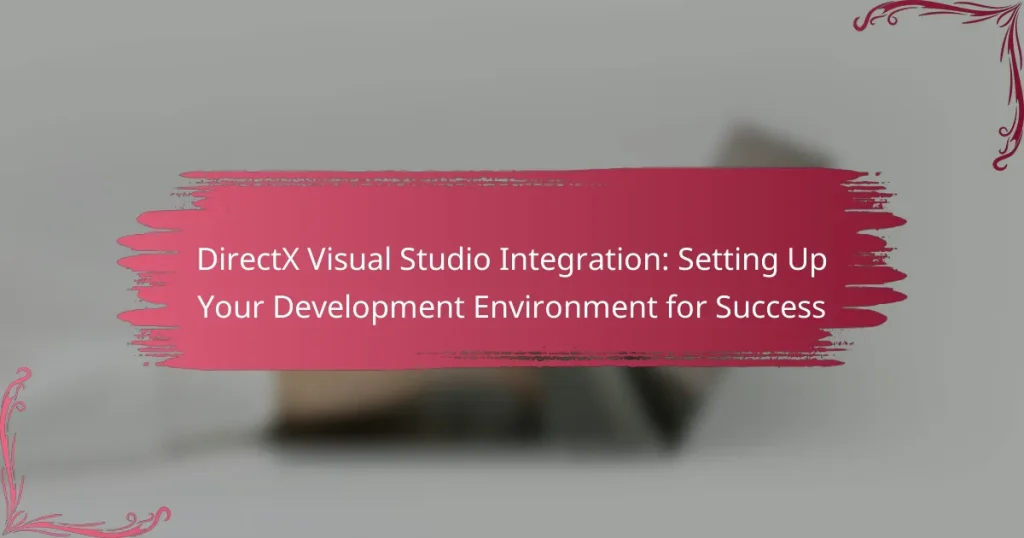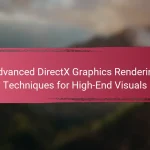DirectX Visual Studio Integration involves the incorporation of DirectX libraries and tools into the Visual Studio development environment, enabling developers to create, compile, and debug graphics-intensive applications effectively. This integration offers essential features like project templates, debugging tools, and direct access to DirectX APIs, significantly enhancing productivity and streamlining workflows. The article provides a step-by-step guide on installing DirectX and Visual Studio, as well as configuring the environment to recognize DirectX libraries. Key configurations include setting include and library directories and linking necessary DirectX libraries to ensure successful application development.

What is DirectX Visual Studio Integration?
DirectX Visual Studio Integration refers to the incorporation of DirectX libraries and tools within the Visual Studio development environment. This integration allows developers to create, compile, and debug DirectX applications seamlessly. It provides essential features such as project templates, debugging tools, and access to DirectX APIs. Developers benefit from enhanced productivity and streamlined workflows. The integration supports various programming languages, including C++ and C#. It facilitates the development of graphics-intensive applications, such as games and simulations. Overall, DirectX Visual Studio Integration is crucial for efficient DirectX application development.
How does DirectX Visual Studio Integration enhance development?
DirectX Visual Studio Integration enhances development by providing seamless access to graphics APIs. It allows developers to utilize DirectX features directly within the Visual Studio environment. This integration streamlines the coding process, reducing the time spent on setup. It also offers real-time debugging tools tailored for graphics programming. Developers can quickly identify and resolve issues in their code. Additionally, it includes templates and sample projects to accelerate development. This feature helps new developers understand best practices quickly. Overall, it increases productivity and efficiency in game and graphics application development.
What are the key features of DirectX Visual Studio Integration?
DirectX Visual Studio Integration offers several key features that enhance game development. It provides a seamless environment for coding, debugging, and testing DirectX applications. The integration includes built-in project templates specifically designed for DirectX projects. Developers benefit from advanced debugging tools tailored for graphics programming. It also supports real-time rendering previews within the Visual Studio interface. Additionally, the integration facilitates easy access to DirectX SDK and libraries. This feature streamlines the process of importing and managing assets. Overall, these capabilities significantly improve workflow efficiency for developers working with DirectX.
How does DirectX support multimedia applications in Visual Studio?
DirectX supports multimedia applications in Visual Studio by providing a set of APIs designed for high-performance graphics and multimedia. These APIs enable developers to create rich graphics, sound, and video experiences in applications. DirectX includes components like Direct3D for rendering 3D graphics and DirectSound for audio playback. The integration with Visual Studio allows for easy access to these APIs through project templates and libraries. Developers can utilize debugging tools and performance analysis features within Visual Studio to optimize their multimedia applications. This support streamlines the development process and enhances the capabilities of applications built for Windows platforms.
Why is setting up a development environment important?
Setting up a development environment is important because it provides a consistent and controlled space for software development. A well-configured environment ensures that all necessary tools and libraries are readily available. This reduces setup time and minimizes compatibility issues. Developers can focus on writing code rather than troubleshooting configuration problems. Additionally, a proper environment allows for efficient debugging and testing. It enhances collaboration among team members by standardizing the development process. Research shows that 70% of developers report increased productivity with a well-organized setup. Overall, a development environment is crucial for successful software development.
What challenges might developers face without proper setup?
Developers might face significant challenges without proper setup in DirectX Visual Studio integration. These challenges include increased debugging difficulties. Without the correct configuration, identifying issues in the code becomes complex and time-consuming. Developers may also encounter performance issues. Improper setup can lead to inefficient resource management, causing applications to run slowly. Additionally, compatibility problems may arise. Without the right environment, certain DirectX features may not function as intended. This can result in unexpected crashes or errors during runtime. Furthermore, developers might struggle with limited access to libraries and tools. A lack of proper setup can restrict the use of essential DirectX functionalities. Overall, these challenges can hinder the development process and affect project timelines.
How can a well-configured environment improve productivity?
A well-configured environment can significantly improve productivity by streamlining workflows and reducing distractions. Proper setup ensures that tools and resources are easily accessible. This minimizes the time spent searching for files or settings. A tailored environment can also enhance focus by eliminating unnecessary clutter. Research shows that organized workspaces can boost efficiency by up to 20%. Additionally, a well-optimized system reduces technical issues, allowing for smoother execution of tasks. This leads to less downtime and more consistent output. Overall, an effective environment fosters a more conducive atmosphere for productivity.

How do you install DirectX and Visual Studio?
To install DirectX, download the DirectX End-User Runtime Web Installer from the Microsoft website. Run the installer and follow the on-screen instructions to complete the installation. This process ensures that your system has the latest DirectX components needed for applications and games.
To install Visual Studio, visit the Visual Studio download page on the Microsoft website. Select the version you want, such as Community, Professional, or Enterprise. Download the installer and run it. Follow the installation prompts, selecting the workloads that fit your development needs. Visual Studio will then install the necessary components and tools for software development.
What are the steps to install Visual Studio for DirectX development?
To install Visual Studio for DirectX development, first, download the Visual Studio installer from the official Microsoft website. Next, run the installer and select the “Game Development with C++” workload. This workload includes essential tools and libraries for DirectX development. After selecting the workload, click on the “Install” button to begin the installation process. Once the installation is complete, launch Visual Studio. Then, create a new project and select a DirectX template to start your development. Finally, ensure that you have the latest Windows SDK installed for optimal compatibility with DirectX.
Which components should be selected during installation?
During installation, select the DirectX SDK, Visual Studio tools, and necessary libraries. The DirectX SDK provides essential files for developing DirectX applications. Visual Studio tools enable integration with the development environment. Necessary libraries include Direct3D, Direct2D, and DirectInput for graphics and input handling. Selecting these components ensures a complete setup for DirectX development.
How do you verify the installation of Visual Studio?
To verify the installation of Visual Studio, open the application and check the version details. Click on the “Help” menu and select “About Microsoft Visual Studio.” The version number will be displayed in the dialog box. Ensure that the version matches the expected one for your project requirements. You can also check for installed components by going to “Tools” and selecting “Get Tools and Features.” This will show a list of installed workloads and components. Confirm that the necessary components for DirectX development are present. If all required elements are installed, the verification is successful.
How do you install DirectX SDK?
To install the DirectX SDK, first, download the SDK from the official Microsoft website. The SDK is available as a standalone installer. After downloading, run the installer and follow the on-screen instructions. Choose the installation directory when prompted. The installation process includes components necessary for DirectX development. Once installation is complete, verify the installation in Visual Studio. You can check for DirectX references in the project settings. This process ensures that the DirectX SDK is properly integrated into your development environment.
What is the process for downloading the DirectX SDK?
To download the DirectX SDK, visit the official Microsoft website. Locate the DirectX SDK download section. Click on the download link for the latest version of the SDK. Follow the on-screen instructions to initiate the download. Once the download is complete, open the installer file. Follow the installation prompts to complete the setup. Ensure your system meets the requirements for the SDK. This process allows developers to access the necessary tools for DirectX development.
How do you integrate the DirectX SDK with Visual Studio?
To integrate the DirectX SDK with Visual Studio, first, download the DirectX SDK from the official Microsoft website. After downloading, install the SDK by following the setup instructions. Next, open Visual Studio and create a new project or open an existing one. In the project properties, navigate to the ‘VC++ Directories’ section. Add the DirectX SDK’s ‘Include’ and ‘Lib’ directories to the respective fields. Then, in the ‘Linker’ section, add the necessary DirectX libraries, such as d3d11.lib or d3d12.lib, to the ‘Additional Dependencies’ list. Finally, ensure that your project’s platform toolset is compatible with the SDK version you installed. This process enables the use of DirectX features in your Visual Studio projects.

What configurations are necessary for DirectX Visual Studio Integration?
To integrate DirectX with Visual Studio, specific configurations are necessary. First, ensure that the DirectX SDK is installed on your system. This SDK provides essential libraries and tools for development. Next, configure Visual Studio to recognize the DirectX libraries. This involves setting the include and library directories in the project properties.
In the project, navigate to Properties > VC++ Directories. Add the path to the DirectX SDK’s include folder. Then, add the path to the library folder. Additionally, link the necessary DirectX libraries in the project settings. This can be done under Properties > Linker > Input. Here, specify the required .lib files such as d3d11.lib or d3dcompiler.lib.
Lastly, ensure that your project is set to use the correct platform toolset that matches the DirectX SDK version. This setup allows for successful compilation and execution of DirectX applications within Visual Studio.
How do you configure project settings for DirectX?
To configure project settings for DirectX, open your Visual Studio project and access the project properties. Navigate to the “Configuration Properties” section. Under “General,” set the “Platform Toolset” to the appropriate version of DirectX. Then, go to “VC++ Directories” and include the DirectX SDK paths for “Include Directories” and “Library Directories.” Next, under “Linker,” add necessary DirectX libraries to “Input” in the “Additional Dependencies” section. Finally, ensure that your project is set to the correct target platform for DirectX compatibility. These steps are essential for successful DirectX development in Visual Studio.
What specific settings need to be adjusted in Visual Studio?
Adjust the following settings in Visual Studio for DirectX integration. First, set the project properties to use the correct platform toolset, typically “v142” or “v143” for compatibility. Next, configure the include directories to point to the DirectX SDK path. Set the library directories to include the appropriate DirectX libraries, such as “d3d11.lib” and “dxguid.lib.” Finally, ensure the linker settings include these libraries in the “Additional Dependencies” section. These adjustments ensure that your development environment is properly configured for DirectX development.
How do you set up include and library directories?
To set up include and library directories in Visual Studio, open the project properties. Navigate to the “Configuration Properties” section. Under “C/C++”, select “General”. Find the “Additional Include Directories” option. Add the path to your DirectX SDK include folder here. Next, under “Linker”, select “General”. Locate the “Additional Library Directories” option. Add the path to your DirectX SDK library folder in this section. This ensures that Visual Studio can locate the necessary files for compiling and linking your DirectX project.
What tools and resources are available for DirectX development?
DirectX development utilizes various tools and resources. Microsoft Visual Studio is the primary Integrated Development Environment (IDE) for DirectX projects. It provides debugging and profiling tools essential for development. The DirectX SDK includes libraries, headers, and samples to facilitate programming. Additionally, DirectX Graphics Tools offer performance analysis and debugging capabilities. Online resources include Microsoft documentation and community forums for troubleshooting and support. Tutorials and courses are also available to enhance learning and implementation skills. These resources collectively ensure a robust development environment for DirectX applications.
Which debugging tools are recommended for DirectX projects?
Recommended debugging tools for DirectX projects include Microsoft PIX, Visual Studio Graphics Debugger, and RenderDoc. Microsoft PIX is a powerful tool specifically designed for debugging DirectX applications. It provides performance analysis and frame capture features. Visual Studio Graphics Debugger integrates seamlessly with Visual Studio. It allows developers to debug graphics rendering issues directly within the IDE. RenderDoc is an open-source frame debugger for 3D graphics applications. It supports multiple graphics APIs, including DirectX. Each tool offers unique features that enhance the debugging process for DirectX projects.
What online resources can assist in learning DirectX?
Online resources that can assist in learning DirectX include official Microsoft documentation, online courses, and community forums. The Microsoft Docs website provides comprehensive guides and tutorials on DirectX features and usage. Platforms like Udemy and Coursera offer structured courses on DirectX programming. Additionally, forums such as Stack Overflow and the DirectX section on Reddit allow users to ask questions and share knowledge. YouTube also hosts numerous tutorial videos that cover DirectX topics extensively. These resources collectively enhance understanding and practical skills in DirectX development.
What are the best practices for developing with DirectX in Visual Studio?
Use the latest version of Visual Studio for DirectX development. This ensures access to the newest features and updates. Set up a dedicated project for DirectX applications. This keeps your code organized and manageable. Utilize the DirectX SDK for essential libraries and tools. The SDK provides necessary resources for development. Follow proper project configuration settings. This includes setting the correct include and library directories. Implement debugging tools effectively. Debugging is crucial for identifying issues in graphics rendering. Use sample code and tutorials from Microsoft. These resources help in understanding DirectX functionalities. Optimize your code for performance. Efficient code enhances the application’s responsiveness and graphics quality. Regularly update your development environment. Keeping everything up to date minimizes compatibility issues.
How can developers optimize their DirectX applications?
Developers can optimize their DirectX applications by reducing draw calls. Fewer draw calls enhance performance by minimizing CPU workload. They should also implement efficient state changes. This includes minimizing changes to shaders and textures during rendering. Developers can utilize instancing to draw multiple objects with a single call. This technique significantly reduces the overhead associated with multiple draw calls. Additionally, leveraging DirectX’s built-in profiling tools helps identify performance bottlenecks. These tools provide insights into how resources are being utilized. Finally, optimizing asset sizes and formats can lead to faster loading times and improved runtime performance.
What common pitfalls should be avoided during development?
Common pitfalls to avoid during development include inadequate planning, which can lead to scope creep. Failing to define project requirements clearly often results in misunderstandings. Ignoring version control can cause loss of code and collaboration issues. Neglecting testing throughout the development cycle increases the risk of bugs in the final product. Overlooking documentation can hinder future maintenance and scalability. Lastly, underestimating time and resource needs can derail project timelines. Each of these pitfalls has been documented in software development literature, emphasizing the importance of thorough preparation and ongoing evaluation.
DirectX Visual Studio Integration is a crucial aspect of developing graphics-intensive applications, providing developers with essential tools and libraries within the Visual Studio environment. This article outlines the benefits of integration, including streamlined workflows, advanced debugging tools, and access to DirectX APIs, enabling efficient game and multimedia application development. It covers installation procedures, necessary configurations, and best practices for optimizing DirectX applications while highlighting common pitfalls to avoid. The content serves as a comprehensive guide for developers seeking to enhance their productivity and success in DirectX development.


